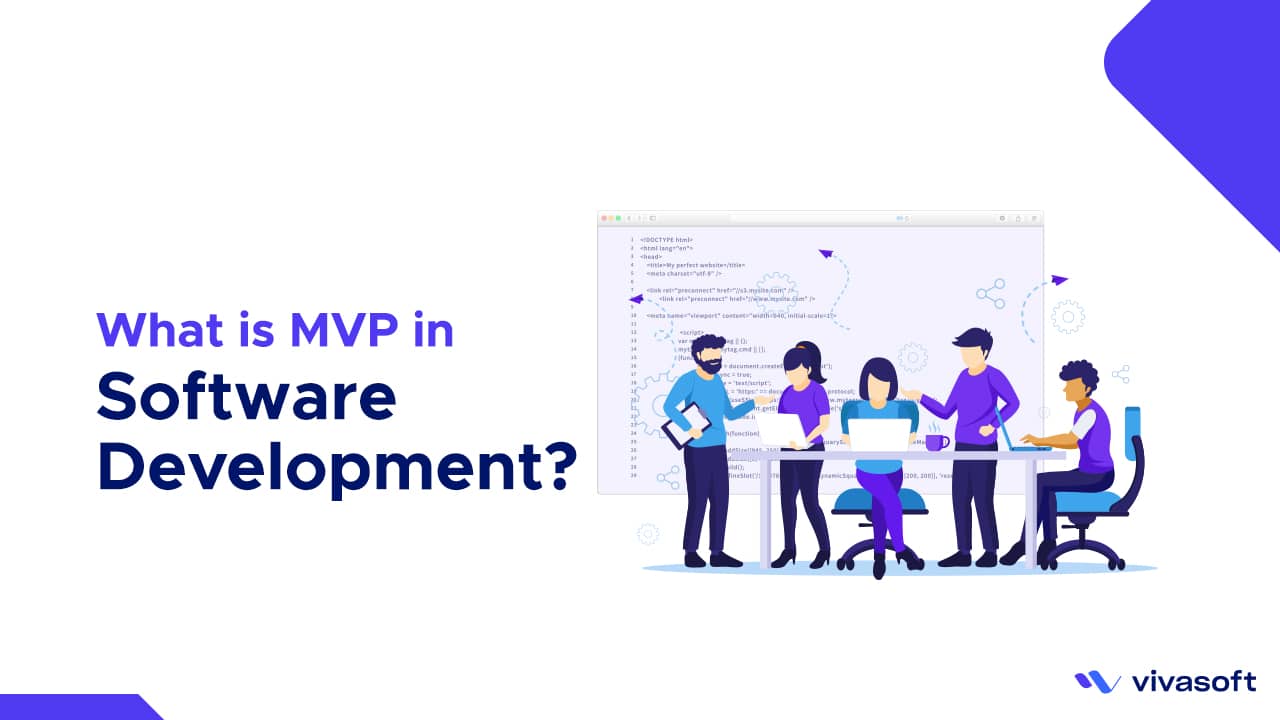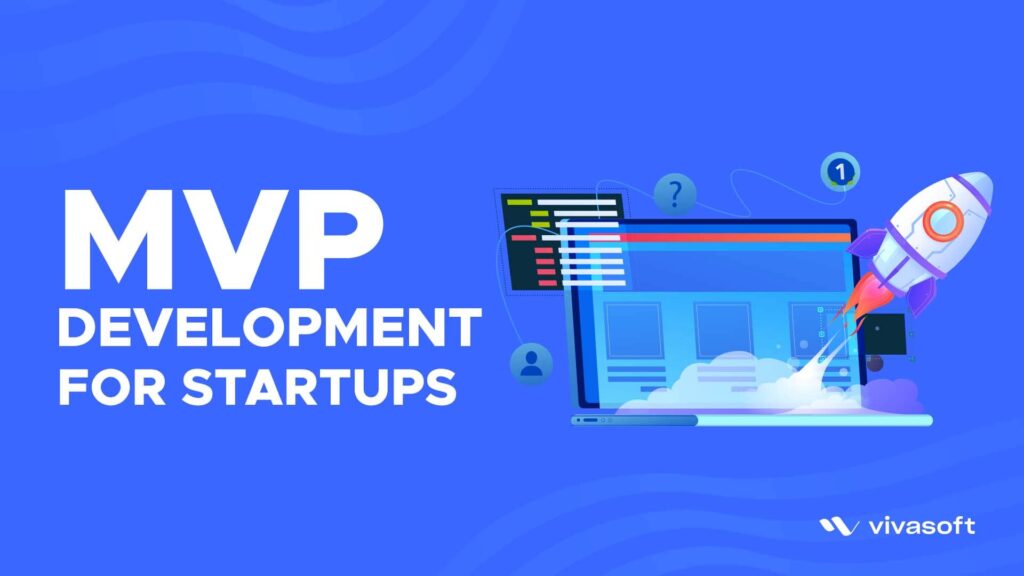In software development, MVP (M= minimum, V = viable, and P = product) means building a product from scratch with minimal features. Modern is an efficient way to build a product usable for early adopters.
For startups, the process eliminates the potential risk. It tests the readiness before launching the final product in the competitive market.
Tech founders or entrepreneurs must be fully aware of MVP in software development. The significance of MVP in software development can help to build the product in many ways. Making an MVP is cost-efficient, emphasizes the product’s core value, and gives a clear picture of the business model.
Throughout the article, we will learn about the purpose of MVP, its characteristics, the development process, and benefits. We will also shed light on some examples of the tech giants in the twentieth century who have developed successful MVPs in the early stages.
What is MVP in Software Development?
Minimum Viable Product (MVP) is the fundamental concept when developing a product in a highly competitive market. The least of work to get out what you want.
An experiment to see how the product would perform how it is developed so far. Aims to collect user feedback, usability, scalability, experience, cost reduction, risk minimization, and product functionality. Either it can be built or released.
The question resonates, who will experiment with the product for the first time?
If you look at the production adoption lifecycle, the early adopters are the primary customers of your product. Early adopters are inherently risk-takers. They will use your product and provide the feedback you want before releasing the final product.
For example, the tech enthusiast Brian Chesky, the founder of Airbnb. Initially, he started by renting his living room with a delicious breakfast. It was named after aibedandbreakfast. But with time, he ended up renting unused space and is looking for accommodation.
The entrepreneurs test the new product in the market and identify its strengths and weaknesses for further development.
Then, the data-driven approach flocks towards the final product development.
MVP might take several months to integrate into a full-fledged functional product. The product comes in different forms, including web development, web application, and app development. The primary objective is to see the visibility with the limited features.
Purpose of MVP in Software Development
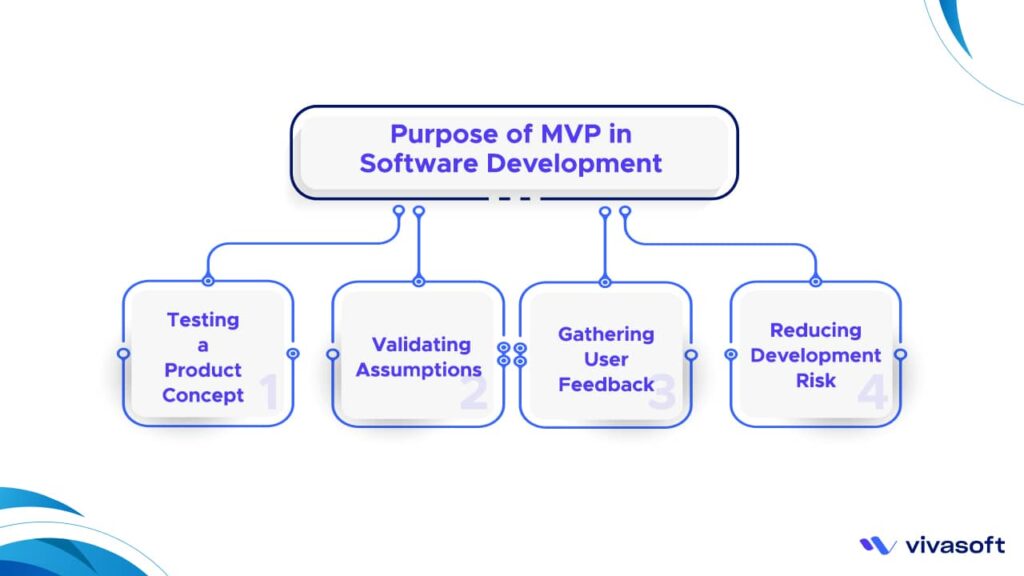
The majority of the startup begins with problem identification. They come up to mitigate the problem with a modern solution. They come to the software developers to develop the product application. The developer recommended building MVP and improving gradually.
A holistic approach to save money in an unsuccessful project, verify the interest of potential users, find early adopters to get feedback, and accelerate product visibility. This portion of the article is about creating MVP in software development.
The primary objectives of developing an MVP are:
Testing The Product Concept
MVP testing is like showing the basic version of the final product to the users in the simplest way. You give them tasks to do with it, and you watch how they use it.
It helps you know what needs to be adjusted if they need help or need help understanding. It’s best to ask users who are unfamiliar with the product so you can gather honest feedback.
For example, if you’re testing a new productivity tool, ask who’s not a line manager to use it. If they struggle to figure it out, you’ll know you need to simplify or explain it better. This way, you make your product better before showing it to everyone.
You can go for customer interviews, pre-orders, free trials, explainer videos, and landing pages.
Dropbox did it so. The file-sharing platform wasn’t open for all that time. You need to register first to get the invitation. They just made funny videos, posted them to the communities, and ended up with an unexpected user base.
Validating Assumptions
What will people look and feel when making a new product? But an MVP helps you find out for real. You make a basic version and let people try it.
Then, you see if they use it the way you planned. Otherwise, you can change your ideas based on what you learn from them. It’s like developing the product until it fits in the market.
For example, you are a tech founder. You want to launch a mobile application where you bridge lost and found owners. Users can take photos, upload them, and share them.
Assumption:. You assume that users want a feature-rich app with a wide range of functionalities because that’s what you believe would be most appealing.
MVP: Instead of building a full-fledged functional app with all the features, you create a basic version of the app with only one core functionality, such as uploading photos of the found items. Ability to take and share photos.
Validation Process
MVP app, allowing users to take photos and share them with the community.
- You release the app to the beta users.
- You gather feedback from the users and track how they use the app.
- You found that users found it problem-solving but needed help navigating the application.
- Users also suggest adding features like location, time, assortment, return policy, ownership, etc.
Based on the beta user’s feedback, you adjust your initial assumption:
Adjusted Assumption: Users are primarily interested in a simple and detailed orientation. Additional complex features are less important than enhancing the core functionality.
In this context, the MVP approach helps you validate assumptions about the app’s features by observing how beta users interact with the basic version.
This allows you to focus on what users truly value and avoid burning time and resources on features that may not be essential to your app’s success.
Gathering User Feedback
MVPs are aimed at gathering user feedback. They allow you to gain insights into what users like, dislike, and find valuable about your product. This feedback is invaluable for making strategic decisions about future development.
Reducing Development Risk
The main objective is to identify the risk factor first. Once you identify and mitigate the risk factor, it becomes cozy. Developing a full-featured product requires validating its product-market fit to be safe.
Starting with an MVP minimizes the risk of investing in a product that may need to gain traction. MVPs help you identify potential issues and challenges early in development, reducing overall development risk.
Go back to our lost and found example. What if you go forward without mitigating the risk factor? You would end up investing in unsuccessful projects.
Characteristics of an MVP in Software Development
The following are the characteristics of an MVP (Minimum Viable Product) in software development.
Minimal Features: MVP has just the basics, like the core features in software development.
For example, building a basic word processing program that lets you type and save text but doesn’t have advanced features like fonts, styles, or spell-check. It includes just what’s necessary to serve its primary purpose.
Core Functionality: The functions that are essential for the software to fulfill its main purpose or solve a specific problem.
Like creating an e-commerce platform, the core functionality would include where shoppers can select products, add to a cart, and check out.
Fast Development: In software development, you can shape the product in the quickest possible time. You don’t need to wait for the fully functional product.
Quick Release: As soon as the development is done, it is ready for quick release.
User-Centric Design: The main objective is to gather user feedback, which is built based on the user’s preference.
Benefits of Using MVP in Software Development
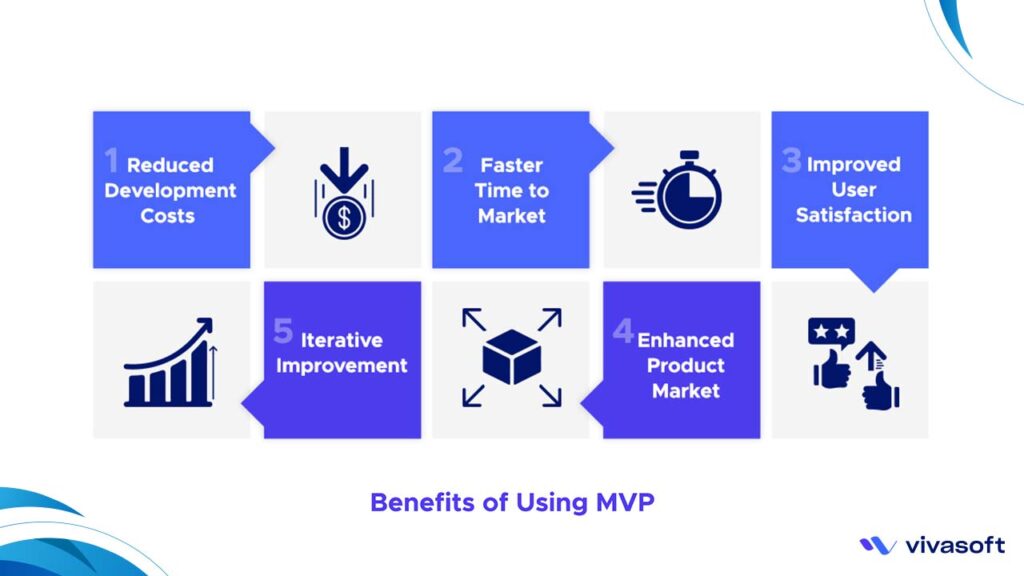
The advantages of adopting an MVP approach in software development:
1. Reduced development costs: To build MVP in software development, there is no need to implement complex functionality. MVPs have only one killer feature. This means the development team needs less time to complete the project. As a result, you will have to pay less for development services.
2. Faster time to market: As the user’s behavior and market changes quickly. So, it’s important to test the idea in the shortest possible time. With the MVP in software development you will get valuable experience much earlier.
3. Improved user satisfaction: When you receive feedback from the early adopters, it will help you to improve user satisfaction.
4. Enhanced product-market fit: MVP in software development helps you validate your product’s fit in the market. You learn if there’s real demand and can adjust your strategy accordingly.
The market fit is gained when the absence of the product will have an impact on the users.
5. Iterative improvement: This term is used in software development. MVP encourages continuous learning and improvement based on user feedback
The MVP Development Process in Software Development
The following steps are involved in MVP (Minimum Viable Product) in software development.
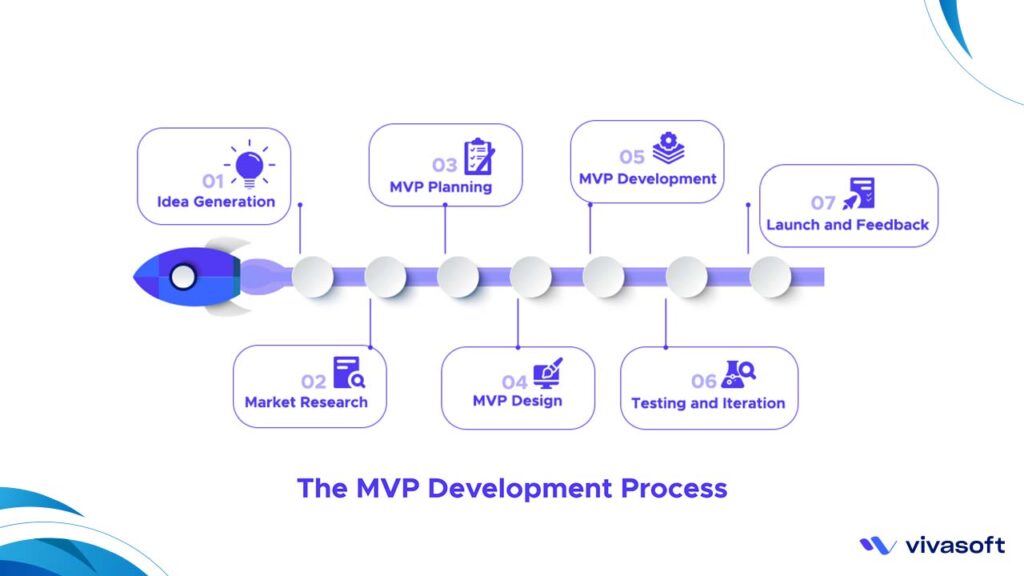
Idea Generation
The tech founder or the entrepreneur has a solution that will give value. Also, you know who are your potential and ultimate users.
Market Research
If you are an entrepreneur, then you must have an idea about market size, demographics, customer insights, market behavior, SWOT analysis, competition and government barriers, and other related activities. These are the factors that will come up front.
MVP Planning
The MVP plan includes how the simplest version of the product will look like, feature selection, scope limitation, design, testing, and validation.
MVP Design
It can come in any form. It can be in a hand-drawn flow chart.
MVP Development
You start building the basic version of your product. In software development, it’s time to assemble different components.
Testing and Iteration
In software development, iteration means repeating process. The basic version, which has core functionalities, can come up with bugs. Once it is free, ask the beta users to test the product. Then, based on their given feedback, you apply improvements.
Launch and Feedback
After making improvements, you release your product to the beta users. You continue to gather feedback and make it even better.
MVP vs. Full Product Development
In software development, the whole product development comes with four stages. Starts with proof of concept (POC), product prototype, and minimum viable product (MVP) and marks the end of releasing the full-fledged product.
But here, we will address MVP and full product in software development. Let’s drill down.
| S/N | Characteristics | Minimum Viauct (MVP)ble Prod | Full Product Development |
|---|---|---|---|
| 1 | Definition | Basic version of the product | Full-fledged and final version of the product |
| 2 | Objective | Focus on core features and gather user feedback | Incorporate the features after user feedback |
| 3 | Target group | Early adopters, investors, targeted beta users | Release for all |
| 4 | Risk factor | Identify and reduce risk | Risk-free full-fledged product |
| 5 | Revenue | Sells to early adopters and seeks seed capital | Seek venture capital |
| 6 | Timeliness | Less time consuming | Time-consuming |
| 7 | Investment | Inexpensive | Expensive |
| 8 | Outcome | Burn unnecessary investment on unsuccessful project | Build a successful final product with proper feedback |
The main benefit you can get is it is time and cost-saving. If you don’t go for MVP in software development, you may incur unnecessary spending. This is also time-consuming.
Examples of Successful MVPs
1. Dropbox
The MVP: Dropbox is a cloud-based file-sharing platform. Initially, it was only open to some. They launched a simple explainer video, getdropbox.com, where beta users sign up with credentials. This simple format of explainer video is the MVP in software development.
Evolution: Dropbox’s MVP generated immense interest and attracted early users. With their feedback, Dropbox expanded its features, including file sharing, collaboration, and mobile support. Today, it’s a household name with millions of users worldwide.
2. Airbnb
The MVP: MVP was a simple website allowing people to rent their air mattresses.
Evolution: They expanded it to include various types of accommodations over time.
3. Twitter
The MVP: Initially, it was a basic microblogging platform where users could post short messages.
Evolution: It added features like mentions, retweets, and images.
4. Spotify
The MVP: The MVP was a music streaming app with a limited song library.
Evolution: Grew by securing licensing agreements and expanding its music catalog.
5. Instagram
The MVP: Started as a photo-sharing app with basic filters.
Evolution: It evolved by adding video sharing, stories, and various editing features.
6. Uber
The MVP: Provide basic ride-sharing services in a limited area.
Evolution: Uber expanded by entering new markets, offering different vehicle types, and adding features like Uber Eats.
7. Groupon
The MVP: Began as a simple daily deal website offering discounts on local services.
Evolution: It expanded by including more cities and diversifying deal categories.
8. Amazon
The MVP: Originally an online bookstore, its MVP offered a limited selection of books.
Evolution: Amazon expanded by adding more product categories and developing a robust e-commerce platform.
These are the tech giants in recent times. The companies started with a basic version of their idea, tested it, gathered user feedback, gradually added features, and expanded their offerings to become the successful platforms we know today.
5 Winning Tips for Building A Successful MVP
Building an effective MVP in software development is a step-by-step guide on how to build an effective MVP.
1. Problem identification: Clearly pinpoint the problem your product aims to solve. The problem should be specific, measurable, and actionable. The basic version of the product is built around the problem identification.
2. Decide the target audience: Only some products solve every problem. People have particular problems and seek personalized solutions.
Try to put more effort into understanding the target audience’s needs, pain points, and preferences. It is the first principle for creating a successful MVP in software development.
3. Selecting the right features: Determine which features are essential to address the identified problem
4. Prioritizing functionality: Start with the most critical features that provide value to users and can be developed within your budget constraints. Keep an eye that you are not investing in unnecessary things.
5. Designing for user experience: Try to make the experience user-friendly. The layout has to be easy to navigate.
These are some guidelines for building a successful MVP in software development.
Common Myths and Misconceptions About MVPs
In the ‘Lean Startup – Eric Ries stated that most problem solvers need to learn what MVP is in software development.
The common misconception about MVP is that it’s a minimal version of your final product. It’s about testing your core assumptions, not just reducing features.
You may have heard about the 80/20 rule. The 20% feedback and insights come from the basic version of the final product.
If they know that MVP is the simplest version containing the final product’s main feature. They can eliminate unnecessary resource allocation, time, effort, and risk management.
Conclusion
Elon Musk’s Tesla is a fine example of creating an MVP in software development. He started by creating a simple electric car that solved a small problem.
The main takeaway from this article is what is MVP in software development. To enlighten the reader, it is the most basic version of your final product.
It contains only a few features. He started with the simplified version, then kept on iterating and continuously solving the more significant issue.
Frequently Asked Questions (FAQ)
How can an MVP benefit startups and businesses?
MVP benefits in several ways. It helps reduce risk, save resources, make it ready to market, gather user feedback, and attract investors.
Is MVP agile or Lean?
An MVP is both Agile and Lean, as it combines Agile development practices with Lean startup principles to create a minimal, flexible, and rapidly adaptable product.
Is an MVP only relevant for new product development?
MVP is relevant for new product development and improving existing products by testing new features or enhancements with minimal resources and risk.
What happens after the MVP stage in software development?
After the MVP stage in software development, the focus shifts to iterating and expanding the product based on user feedback and market needs, leading to successive versions with more features and improvements.
Can an MVP change significantly over time?
Yes, an MVP can change significantly over time as it evolves based on user feedback and market demands.




